Instruction
Keep Your Head Down: The Inexperienced Fix
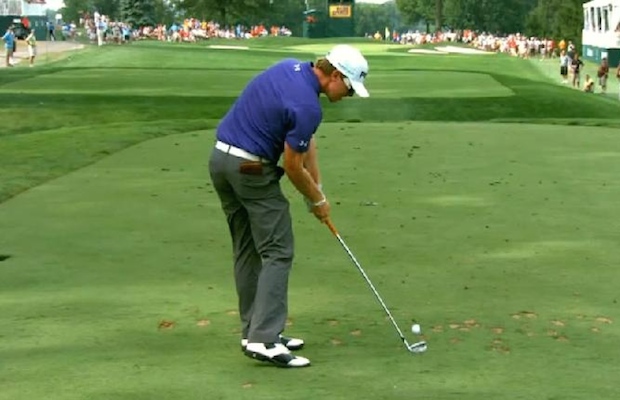
Good ball contact is one of the most challenging skill sets a beginning golfer has to develop. Unfortunately, bad ball contact is far too frequently diagnosed with the simple analysis of “you’re lifting your head up.”
Rather than see a world of inexperienced golfers continue to be diagnosed with this one fault, effects all malady, let’s take a look at a couple of the true causes as to why a golfer might be “lifting up your head.”
First, let’s understand that three of the next four scenarios for bad ball contact stem from the golf club traveling at its lowest point (or the bottom of the swing arc) prior to striking the golf ball. We’ll use a hula hoop in many of the following photos to represent where a golf club travels through space. The seat of the chair will represent the ground.
Note how the first photo represents a good impact position. The front edge of the chair, directly underneath the model’s shirt buttons, represents where the golf club will be striking the golf ball.
Allow me a little wiggle room, but note how the hula hoop travels at its lowest point just after the front edge of the chair. If a golf ball was just to the left, or on the backswing side of the edge of the chair, perfect ball contact would be achieved.
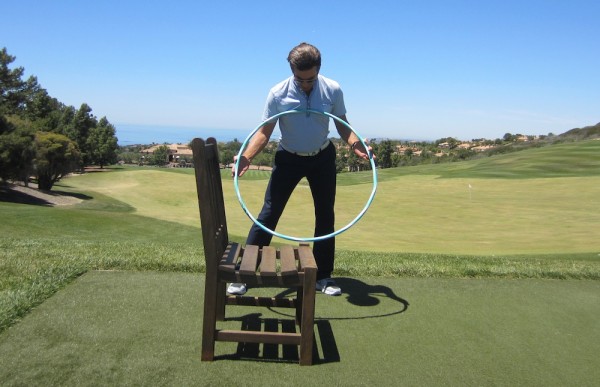
The hula hoop represents the shape of the golf club’s downswing arc. The edge of the chair represents the location of the ball.
In the photo below, notice how the hula hoop is underneath the seat of the chair. This specific scenario represents an individual with bad posture (too hunched over or too low) or a golf swing with body motion that gets excessively lower to the ground during the backswing.
When a golfer has these faults, his or her swing arc also gets lower (note how the hula hoop first makes contact near the seat back of the chair), which in turn effectively moves the bottom of the swing well before the good impact position described. If this golfer wants to hit the right part of the golf ball with this set up or backswing, he MUST raise his posture (or lift his head) to counter the poor technique.
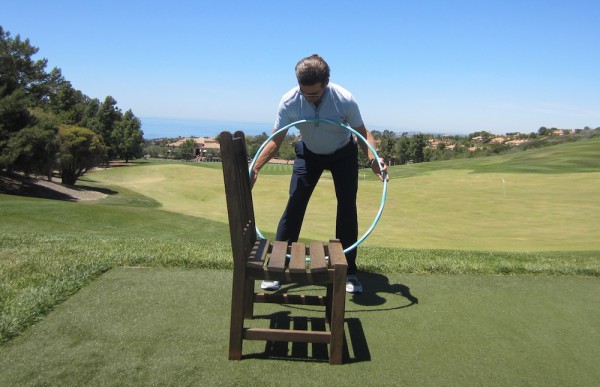
This golfer needs either a taller, more balanced set up, or he must maintain his posture during his backswing motion.
In the third photo, notice how the hula hoop is well behind the proper impact position described in the first photo. This position frequently represents a golfer who does not laterally move toward the target enough during the downswing sequence. Because there is not enough lateral motion, the bottom of the swing arc is behind the golf ball again. This golfer usually suffers from a misunderstanding of a proper weight transfer, or the need to have a slightly descending strike prior to impact for better ball contact.
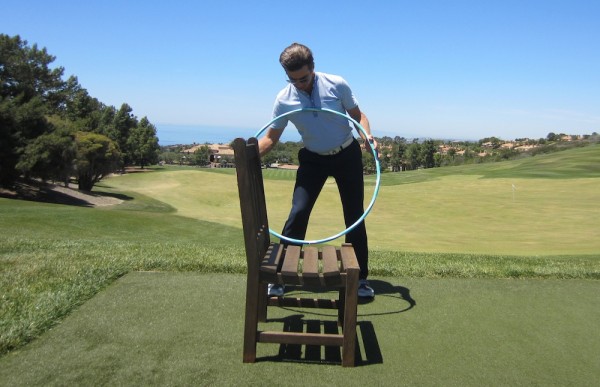
This golfer needs more forward lateral motion to move the bottom of the swing arc forward, and/or a better descending strike.
The fourth and fifth photos represent two different deliveries of the golf club into the impact zone. The first golfer is delivering the golf club with a later hit, or more descending angle of attack due to the club head being three feet above the ground, while his hands are only slightly behind the golf ball. The likelihood of this golfer hitting the turf prior to the ball is very slim, due to how much downward motion the club head needs to make to hit the golf ball from this position.
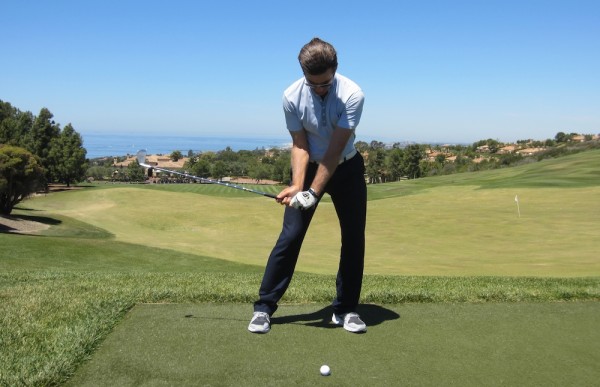
Due to a better wrist hinge, this golfer will unlikely need to lift his head up to strike the ball solidly.
The second golfer is is delivering the golf club with an early hit, or more of an ascending angle of attack. Notice how the club head is only inches away from the ground while the hands are near the back swing leg. There is a very good chance, from this position, that the club head will strike the ground prior to the golf ball, due to how little downward motion this club head needs to make, while still needing to significantly travel forward.
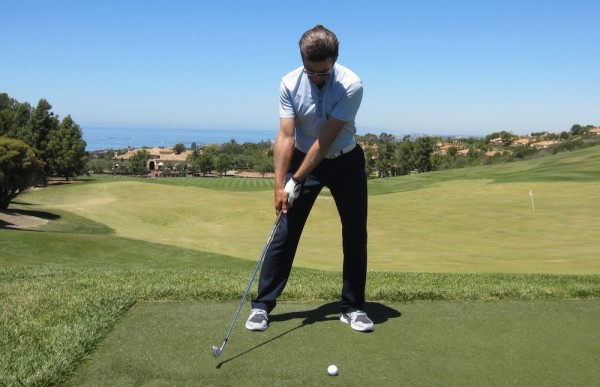
This golfer has released his wrist hinge too early. The golf club is traveling too close to the ground prior to impact.
The last series of photos represents a golfer who lifts his head due to a poor downswing plane that is not in line with the golf ball for proper impact.
The first picture represents a golfer with a proper swing plane. Again the edge of the chair represents the golf ball on the ground. Note how the first model’s hula hoop is matched up to an on-plane downswing where the golf club will be traveling on an arc that will encourage good ball contact.
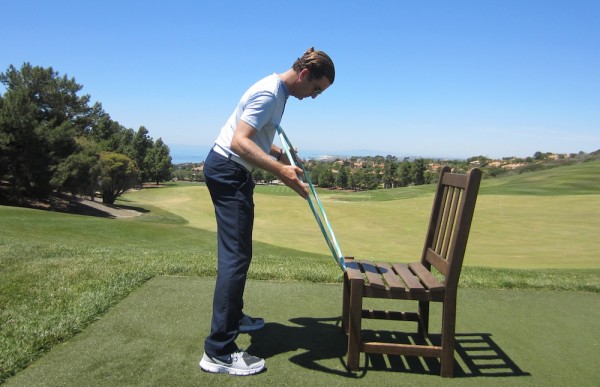
Note how the hula hoop points at the desired impact position, the edge of the chair.
The second picture represents a downswing plane that is too vertical, or steep. Notice how the hula hoop is now traveling well inside the location of the edge of the chair, or the golf ball.
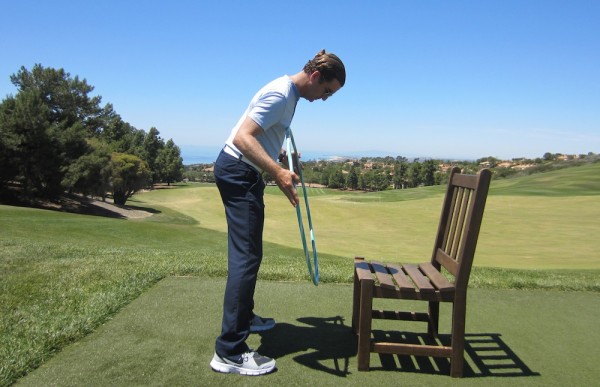
The hula hoop is not pointing at the proper impact position to strike a golf ball. Rather, it is pointing at a spot where there is no golf ball.
In an effort to bring the hula hoop on the proper path of the golf ball, the model raises his head and posture to have a better chance of having the golf club travel on a plane that will strike the golf ball solidly.
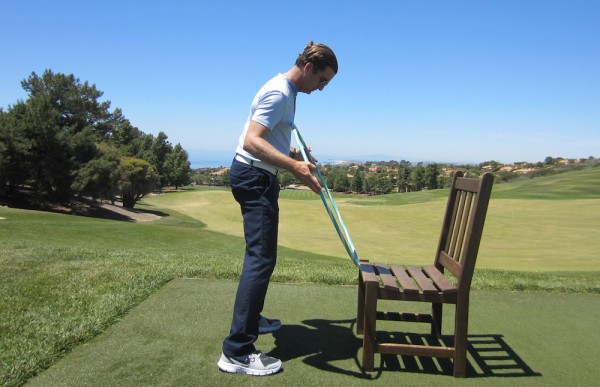
Note how the spine and head have risen, which has helped reroute the hula hoop to a path for better impact.
All of these faults have different fixes. The key for you, the reader, is to understand which fault (single or multiple) is the primary cause for your bad ball contact and the subsequent lifting of the head. You can then do the research (lessons, internet) to apply the proper fix for your specific need.
Best of luck!
- LIKE5
- LEGIT0
- WOW0
- LOL0
- IDHT0
- FLOP0
- OB0
- SHANK0
Instruction
The Wedge Guy: The easiest-to-learn golf basic

My golf learning began with this simple fact – if you don’t have a fundamentally sound hold on the golf club, it is practically impossible for your body to execute a fundamentally sound golf swing. I’m still a big believer that the golf swing is much easier to execute if you begin with the proper hold on the club.
As you might imagine, I come into contact with hundreds of golfers of all skill levels. And it is very rare to see a good player with a bad hold on the golf club. There are some exceptions, for sure, but they are very few and very far between, and they typically have beat so many balls with their poor grip that they’ve found a way to work around it.
The reality of biophysics is that the body moves only in certain ways – and the particulars of the way you hold the golf club can totally prevent a sound swing motion that allows the club to release properly through the impact zone. The wonderful thing is that anyone can learn how to put a fundamentally sound hold on the golf club, and you can practice it anywhere your hands are not otherwise engaged, like watching TV or just sitting and relaxing.
Whether you prefer an overlap, interlock or full-finger (not baseball!) grip on the club, the same fundamentals apply. Here are the major grip faults I see most often, in the order of the frequency:
Mis-aligned hands
By this I mean that the palms of the two hands are not parallel to each other. Too many golfers have a weak left hand and strong right, or vice versa. The easiest way to learn how to hold the club with your palms aligned properly is to grip a plain wooden ruler or yardstick. It forces the hands to align properly and shows you how that feels. If you grip and re-grip a yardstick several times, then grip a club, you’ll see that the learning curve is almost immediate.
The position of the grip in the upper/left hand
I also observe many golfers who have the butt of the grip too far into the heel pad of the upper hand (the left hand for right-handed players). It’s amazing how much easier it is to release the club through the ball if even 1/4-1/2″ of the butt is beyond the left heel pad. Try this yourself to see what I mean. Swing the club freely with just your left hand and notice the difference in its release from when you hold it at the end of the grip, versus gripping down even a half inch.
To help you really understand how this works, go to the range and hit shots with your five-iron gripped down a full inch to make the club the same length as your seven-iron. You will probably see an amazing shot shape difference, and likely not see as much distance loss as you would expect.
Too much lower (right) hand on the club
It seems like almost all golfers of 8-10 handicap or higher have the club too far into the palm of the lower hand, because that feels “good” if you are trying to control the path of the clubhead to the ball. But the golf swing is not an effort to hit at the ball – it is a swing of the club. The proper hold on the club has the grip underneath the pad at the base of the fingers. This will likely feel “weak” to you — like you cannot control the club like that. EXACTLY. You should not be trying to control the club with your lower/master hand.
Gripping too tightly
Nearly all golfers hold the club too tightly, which tenses up the forearms and prevents a proper release of the club through impact. In order for the club to move back and through properly, you must feel that the club is controlled by the last three fingers of the upper hand, and the middle two fingers of the lower hand. If you engage your thumbs and forefingers in “holding” the club, the result will almost always be a grip that is too tight. Try this for yourself. Hold the club in your upper hand only, and squeeze firmly with just the last three fingers, with the forefinger and thumb off the club entirely. You have good control, but your forearms are not tense. Then begin to squeeze down with your thumb and forefinger and observe the tensing of the entire forearm. This is the way we are made, so the key to preventing tenseness in the arms is to hold the club very lightly with the “pinchers” — the thumbs and forefingers.
So, those are what I believe are the four fundamentals of a good grip. Anyone can learn them in their home or office very quickly. There is no easier way to improve your ball striking consistency and add distance than giving more attention to the way you hold the golf club.
More from the Wedge Guy
- The Wedge Guy: Golf mastery begins with your wedge game
- The Wedge Guy: Why golf is 20 times harder than brain surgery
- The Wedge Guy: Musings on the golf ball rollback
- LIKE86
- LEGIT13
- WOW6
- LOL1
- IDHT0
- FLOP4
- OB1
- SHANK8
Instruction
Clement: Stop ripping off your swing with this drill!

Not the dreaded headcover under the armpit drill! As if your body is defective and can’t function by itself! Have you seen how incredible the human machine is with all the incredible feats of agility all kinds of athletes are accomplishing? You think your body is so defective (the good Lord is laughing his head off at you) that it needs a headcover tucked under the armpit so you can swing like T-Rex?
- LIKE0
- LEGIT2
- WOW2
- LOL0
- IDHT0
- FLOP0
- OB0
- SHANK2
Instruction
How a towel can fix your golf swing

This is a classic drill that has been used for decades. However, the world of marketed training aids has grown so much during that time that this simple practice has been virtually forgotten. Because why teach people how to play golf using everyday items when you can create and sell a product that reinforces the same thing? Nevertheless, I am here to give you helpful advice without running to the nearest Edwin Watts or adding something to your Amazon cart.
For the “scoring clubs,” having a solid connection between the arms and body during the swing, especially through impact, is paramount to creating long-lasting consistency. And keeping that connection throughout the swing helps rotate the shoulders more to generate more power to help you hit it farther. So, how does this drill work, and what will your game benefit from it? Well, let’s get into it.
Setup
You can use this for basic chip shots up to complete swings. I use this with every club in my bag, up to a 9 or 8-iron. It’s natural to create incrementally more separation between the arms and body as you progress up the set. So doing this with a high iron or a wood is not recommended.
While you set up to hit a ball, simply tuck the towel underneath both armpits. The length of the towel will determine how tight it will be across your chest but don’t make it so loose that it gets in the way of your vision. After both sides are tucked, make some focused swings, keeping both arms firmly connected to the body during the backswing and follow through. (Note: It’s normal to lose connection on your lead arm during your finishing pose.) When you’re ready, put a ball in the way of those swings and get to work.

Get a Better Shoulder Turn
Many of us struggle to have proper shoulder rotation in our golf swing, especially during long layoffs. Making a swing that is all arms and no shoulders is a surefire way to have less control with wedges and less distance with full swings. Notice how I can get in a similar-looking position in both 60° wedge photos. However, one is weak and uncontrollable, while the other is strong and connected. One allows me to use my larger muscles to create my swing, and one doesn’t. The follow-through is another critical point where having a good connection, as well as solid shoulder rotation, is a must. This drill is great for those who tend to have a “chicken wing” form in their lead arm, which happens when it becomes separated from the body through impact.
In full swings, getting your shoulders to rotate in your golf swing is a great way to reinforce proper weight distribution. If your swing is all arms, it’s much harder to get your weight to naturally shift to the inside part of your trail foot in the backswing. Sure, you could make the mistake of “sliding” to get weight on your back foot, but that doesn’t fix the issue. You must turn into your trial leg to generate power. Additionally, look at the difference in separation between my hands and my head in the 8-iron examples. The green picture has more separation and has my hands lower. This will help me lessen my angle of attack and make it easier to hit the inside part of the golf ball, rather than the over-the-top move that the other picture produces.


Stay Better Connected in the Backswing
When you don’t keep everything in your upper body working as one, getting to a good spot at the top of your swing is very hard to do. It would take impeccable timing along with great hand-eye coordination to hit quality shots with any sort of regularity if the arms are working separately from the body.
Notice in the red pictures of both my 60-degree wedge and 8-iron how high my hands are and the fact you can clearly see my shoulder through the gap in my arms. That has happened because the right arm, just above my elbow, has become totally disconnected from my body. That separation causes me to lift my hands as well as lose some of the extension in my left arm. This has been corrected in the green pictures by using this drill to reinforce that connection. It will also make you focus on keeping the lead arm close to your body as well. Because the moment either one loses that relationship, the towel falls.


Conclusion
I have been diligent this year in finding a few drills that target some of the issues that plague my golf game; either by simply forgetting fundamental things or by coming to terms with the faults that have bitten me my whole career. I have found that having a few drills to fall back on to reinforce certain feelings helps me find my game a little easier, and the “towel drill” is most definitely one of them.
- LIKE12
- LEGIT2
- WOW2
- LOL0
- IDHT0
- FLOP2
- OB0
- SHANK8
-

 19th Hole2 weeks ago
19th Hole2 weeks agoDave Portnoy places monstrous outright bet for the 2024 Masters
-

 19th Hole2 weeks ago
19th Hole2 weeks agoTiger Woods arrives at 2024 Masters equipped with a putter that may surprise you
-

 19th Hole21 hours ago
19th Hole21 hours ago‘Absolutely crazy’ – Major champ lays into Patrick Cantlay over his decision on final hole of RBC Heritage
-

 19th Hole3 weeks ago
19th Hole3 weeks agoReport: Tiger Woods has ‘eliminated sex’ in preparation for the 2024 Masters
-

 19th Hole1 week ago
19th Hole1 week agoTwo star names reportedly blanked Jon Rahm all week at the Masters
-

 19th Hole1 week ago
19th Hole1 week agoReport: LIV Golf identifies latest star name they hope to sign to breakaway tour
-

 19th Hole1 week ago
19th Hole1 week agoNeal Shipley presser ends in awkward fashion after reporter claims Tiger handed him note on 8th fairway
-

 19th Hole6 days ago
19th Hole6 days agoBrandel Chamblee has ‘no doubt’ who started the McIlroy/LIV rumor and why















Kevin White
Dec 11, 2014 at 7:40 am
Visit the website listed and see the head position of many pros shortly after impact. Keeping your head down thru impact is all mental.
Kevin White
Dec 11, 2014 at 7:41 am
Here is that website…www.headdown.com/about.html
petie3
May 13, 2014 at 8:07 am
I cured a 30 year slice in 20 minutes by taking a camcorder on a tripod and simply taping myself with the camera directly behind, then at 90 degrees. When you ‘feel’ your swing is down the line, it is actually outside-in. Same as a batter in baseball, when you feel you’re swinging level you are uppercutting. To hit level you must consciously hit down on the ball. My fix was to separate the slower backswing from the downswing by a tiny motionless fraction and then initiate the downswing with the hips.
Now if I could only putt.
Alex
May 9, 2014 at 11:54 am
An old friend who happens to be a very good amateur told me once: “look at the ball intently,” meaning “be aware of the ball throughout the swing”. That’s one of the best tips I’ve ever received in 30 year of golf.
Today, I only look at the ball. I don’t think whether my head’s moving or rising, I can see the white ball on the grass all along the swing and it’s gonna be a fine shot.
Nick
May 8, 2014 at 11:41 am
I also think another scenario is the player who, for lack of a better image,”humps the goat” which is a lost of posture where the hips move forward and the head moves away (not so much up) from the ball which can either lead to skulls or promote an early release which when conducted with proper posture, or when not times perfectly, will result in poor contact and face control issues. A lot of people who set up with too much knee flex seem to fall into this fault. Its similar to the last illustration in the article but I believe different in some important respects in that its no so much a plane issue as a set up and posture issue.
Tim
May 19, 2014 at 12:31 pm
Well said Nick!
Teekman
May 8, 2014 at 1:11 am
While I see what you are saying here I think the bigger issue with the statement “keep your head down” is the disconnect between the person saying it and the person swinging the club. When I tell friends “keep your head down” I rephrase it by saying “keep a steady head” because that’s what I find to be the biggest issue with new golfers. Anyone can set up well to the ball, however it’s the balance and steadiness that comes with practice that they lack. Other than that, great article.